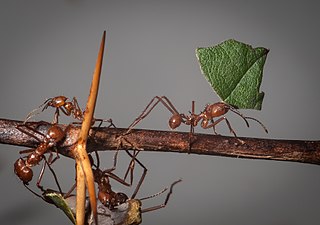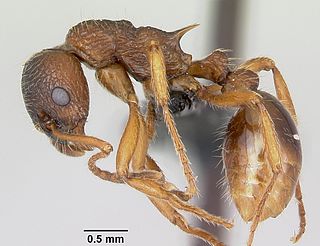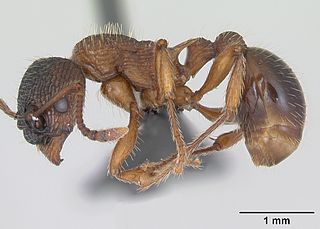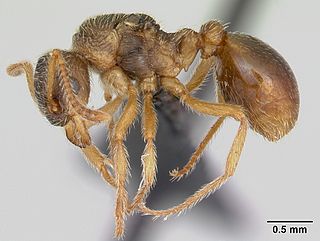
Formica is a genus of ants of the family Formicidae, commonly known as wood ants, mound ants, thatching ants, and field ants. Formica is the type genus of the Formicidae, and of the subfamily Formicinae. The type species of genus Formica is the European red wood ant Formica rufa. Ants of this genus tend to be between 4 and 8 mm long.

The large blue is a species of butterfly in the family Lycaenidae. The species was first defined in 1758 and first recorded in Britain in 1795. In 1979 the species became mostly extinct in Britain but has been successfully reintroduced with new conservation methods. The species is classified as "near threatened" on the IUCN Red List of Threatened Species. Today P. arion can be found in Europe, the Caucasus, Armenia, western Siberia, Altai, north-western Kazakhstan and Sichuan.

Myrmica rubra, also known as the common red ant or erroneously the European fire ant, is a species of ant of the genus Myrmica, found all over Europe and is now invasive in some parts of North America and Asia. It is mainly red in colour, with slightly darker pigmentation on the head. These ants live under stones and fallen trees, and in soil. They are aggressive, often attacking rather than running away, and are equipped with a stinger, though they lack the ability to spray formic acid like the genus Formica.

Myrmicinae is a subfamily of ants, with about 140 extant genera; their distribution is cosmopolitan. The pupae lack cocoons. Some species retain a functional sting. The petioles of Myrmicinae consist of two nodes. The nests are permanent and in soil, rotting wood, under stones, or in trees.

Myrmica is a genus of ants within the subfamily Myrmicinae. It is widespread throughout the temperate regions of the Holarctic and high mountains in Southeast Asia.

Phengaris rebeli, common name mountain Alcon blue, is a species of butterfly in the family Lycaenidae. It was first found and described in Styria, Austria, on Mount Hochschwab around 1700. Although it was initially classified as a subspecies of P. alcon, a European researcher, Lucien A. Berger, designated it as a separate species in 1946. Genetic similarities between P. rebeli and P. alcon have led many researchers to argue that the two are the same species and differences are due to intraspecific variation.

Cardiocondyla is an Old World genus of ants in the subfamily Myrmicinae.

Camponotus vagus is a species of large, black, Palaearctic carpenter ant with a wide range that includes much of Europe, a large area of Asia, and part of Africa.

Myrmica ruginodis is a species of ant that lives in northern parts of Europe and Asia. It is very similar to M. rubra, but has a more northerly and higher-altitude distribution. Overwintering larvae may become either workers or queen ants, with up to 20 queens living in a colony of up to 2,500 individuals. Two subspecies are recognised, differing in the relative size of the queen.

Myrmica scabrinodis is a Euro-Siberian species of ant. It lives in moderately humid habitats, tolerates soil moisture but also needs direct sunshine. It often inhabits peat bogs. It builds nests in the ground, in grass or moss tussocks, even under stones or in rotten wood. Its colonies are monogynous or have only a few queens and may contain about 2500 workers. This ant species is the main host of the entomopathogenic fungus Rickia wasmannii. Phengaris caterpillars are primary threats of M. scabrinodis with specific species such as Phengaris arion developing a predatory relationship.

Myrmica lonae is a species of ant distributed across South, Central and North Europe, East Europe, Asia Minor, the Caucasus, West Siberian Plain and Northern Kazakhstan. It inhabits humid meadows both in the plains and in the mountains. It nests in the ground, under stones, or in moss. It forms polygynous colonies with up to 1000 workers or more.

Myrmica vandeli is an ant species found sporadically across several European countries. It often coexists with M. scabrinodis. It lives in open, wet meadows. Nests are typically constructed in moss pads. Polygynous colonies may contain 1500 workers. Larvae of Phengaris butterflies may parasitize their colonies.

Myrmica schencki is a species of ant in the genus Myrmica.

Myrmica gallienii is an ant species distributed from Central Europe to West Siberia. Also found in Sweden, Finland, Hungary, Bulgaria and Romania. It lives in wet grasslands and swamps, often in saline land. It builds shallow nests with a soil mound in moist habitats but deep nests in sandy areas. Colonies are relatively large with thousands of individuals.

Myrmica karavajevi is a workerless, socially parasitic ant species: it is widely distributed across Europe. It lives in nests of other species that inhabit warm and humid habitats.

Myrmica lobicornis is an ant species distributed through the planes of North Europe and the mountains of Central and Southern Europe. It is also found in the forest zone of East Europe, the Caucasus, West Siberia, North-East Kazakhstan, East Siberia, and Mongolia stretching until Transbaikalia in the East. It inhabits coniferous or mixed woodlands, occasionally also meadows. It mostly nests in the ground, forms monogynous colonies containing a few hundred workers.

Formica cinerea is a species of ant in the family Formicidae.

Rickia wasmannii is a species of the widely distributed entomoparasitic order of fungi Laboulbeniales. It is an obligatory ectoparasite of ants of the genus Myrmica. The thalli penetrate outer layer of the cuticle, and appear on the host body surface. Little is known about its effect on the host ant, but it is usually regarded as a rather neutral symbiont. Contrarily, however, a recent study has documented an increased need of drinking water and a shortened life-span of infected ants.
Pristomyrmex rasnitsyni is an extinct species of ant in the genus Pristomyrmex. The species is known from a single Late Eocene fossil which was found in Europe.


















